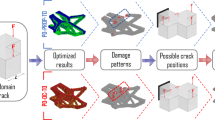Abstract
Damage accumulation and fracture of structures represented an actual mechanical problem that is needed in development of theoretical and computational methods. One of the most important problems in this direction is the problem of optimal structural design, when in optimization process it is necessary to take into account initial structural defects, arising cracks and damage accumulation. This problem is characterized by incomplete information concerning initial cracks size, cracks position and its orientation. In this context it is necessary to develop the statements of the optimization problems based on guaranteed (mini–max), probabilistic and mixed probabilistic-guaranteed approaches for considered problems with incomplete information. For many realistic it is reasonable to use variants of the mini–max optimization, named as optimization for “the worst case scenario” (see Banichuk et al. Mech Struct Mach 26(1):149–188, 1997; Mech Based Des Struct Mach 31(4):459–474, 2003; Meccanica 40:135–145, 2005a; Mech Based Des Struct Mach 33(2): 253–269, 2005b). Considered problem consist in finding the shape and thickness distribution of axisymmetric quasi-brittle shells with arising cracks in such a way, that the cost functional (volume or weight of the shell material) reaches the minimum, while satisfying some constraints on the stress intensity factor and geometrical constraints. In the case of cycling loadings we consider the number of loading cycles before fracture as the main constraint. Some examples of problems formulations, analytical and numerical solutions based on genetic algorithm are presented.
Similar content being viewed by others
Abbreviations
- α, β, γ, hmin, σ1, σ2, V0:
-
Given dimensionless parameters of optimization problems
- C,m:
-
Material constants
- \({\varepsilon}\) :
-
Positive value
- hmin, hmax, L, r m :
-
Geometrical parameters of the shell
- h (x), r(x):
-
Thickness distribution and shape function—design variables
- J, Ja, J i :
-
Functionals in the optimization problem
- \({K_{1}, K_{1C}, K_{1\varepsilon}}\) :
-
Stress intensity factor and quasi-brittle strength constants
- l, l i , l cr :
-
Geometrical parameters of cracks
- Λ, Λ q , Λξ, Λ ω :
-
Given sets, characterizing the incompleteness of information
- μ i :
-
Arbitrary positive constants
- n, n cr , n*:
-
Parameters of cyclic loading
- n pop :
-
The number of populations (iterations)
- r g (x):
-
Given function
- ψ i :
-
Dimensionless functions introduced in Eqs. 10–15
- Ψ i :
-
Dimensionless functions introduced in Eqs. 17–18
- ω :
-
Vector of unknown parameters
References
Abdi R, Touratier M, Convert P (1996) Optimal design for minimum weight in cracked pressure vessel of a turboshaft. Commun Numer Meth Eng 12: 271–280
Banichuk NV (1996) Free boundary optimization under fracture mechanics constraints. Analete Stiintifice, Universitatii. OVIDIUS. Constanta 5(1): 13–20
Banichuk NV (1997) Optimal design of quasi-brittle elastic bodies with cracks. Mech Struct Mach 26(1): 149–188
Banichuk NV (1998) Optimal design of quasi-brittle elastic bodies with cracks. Mech Struct Mach 26(4): 365–376
Banichuk NV, Neittaanmäki P (2007) On structural optimization with incomplete information. Mech Based Des Struct Mach 35(1): 76–95
Banichuk NV, Ragnedda F, Serra M (1999) Probabilistic approaches for optimal beam design based on fracture mechanics. Meccanica 34(1): 29–38
Banichuk NV, Ragnedda F, Serra M (2003) Probabilistic-guaranteed optimal design of membrane shells against quasi-brittle fracture. Mecha Based Des Struct Mach 31(4): 459–474
Banichuk NV, Barthold FJ, Serra M (2005) Optimization of axisymmetric shells against brittle fracture. Meccanica 40: 135–145
Banichuk NV, Ivanova SYu, Makeev EV, Sinitsin AV (2005) Optimal shape design of axisymmetric shells for crack initiation and propagation under cyclic loading. Mech Based Des Struct Mach 33(2): 253–269
Borovkov A, Palmov V, Banichuk N, Stein E, Saurin V, Barthold F, Misnik Yu (2000) Macrofailure criterion and optimization of composite structures with edge delamination. Int J Comput Civil Struct Eng 1(1): 91–104
Hellan K (1984) Introduction to fracture mechanics. Mc-Graw-Hill, New York
Kanninen MF, Popelar CH (1985) Advanced fracture mechanics. Oxford University Press, New York
Lyubimov AK, Makarenko FV (1996) Probability approach to the optimization problem of a reinforced plate with a crack. In Applied problems of strength and plasticity. KMK Scientific Press, Moscow, pp 120–131
Papila M, Haftka RT (2003) Implementation of a crack propagation constraint within a structural optimization software. Struct Optim 25: 327–338
Serra M (2000) Optimum beam based on fatigue crack propagation. Struct Multidisc Optim 19(2): 159–163
Thomsen NB, Karihaloo BL (1995) Optimum microstructure of transformation-toughened ceramics for enhanced wear performance. J Am Ceram Soc 78(1): 3–8
Thomsen NB, Wang J, Karihaloo BL (1994) Optimization—a tool in advanced material technology. Struct Optim 8: 9–15
Vitali R, Haftka RT, Sankar BV (2002) Multi-fidelity design of stiffned composite panel with a crack. Struct Multidisc Optim 23(5): 347–356
Wang J, Karihaloo BL (1995) Fracture mechanics and optimization—a useful tool for fibre-reinforced composite design. Compos Struct 32: 453–466
Yu X, Choi KK, Chang KX (1997) A mixed design approach for probabilistic structural durability. Struct Optim 14: 81–90
Author information
Authors and Affiliations
Corresponding author
Rights and permissions
About this article
Cite this article
Banichuk, N.V., Ivanova, S.Y. & Ragnedda, F. Design of fracture resistant structures. Int J Fract 150, 213–220 (2008). https://doi.org/10.1007/s10704-008-9222-6
Received:
Accepted:
Published:
Issue Date:
DOI: https://doi.org/10.1007/s10704-008-9222-6




